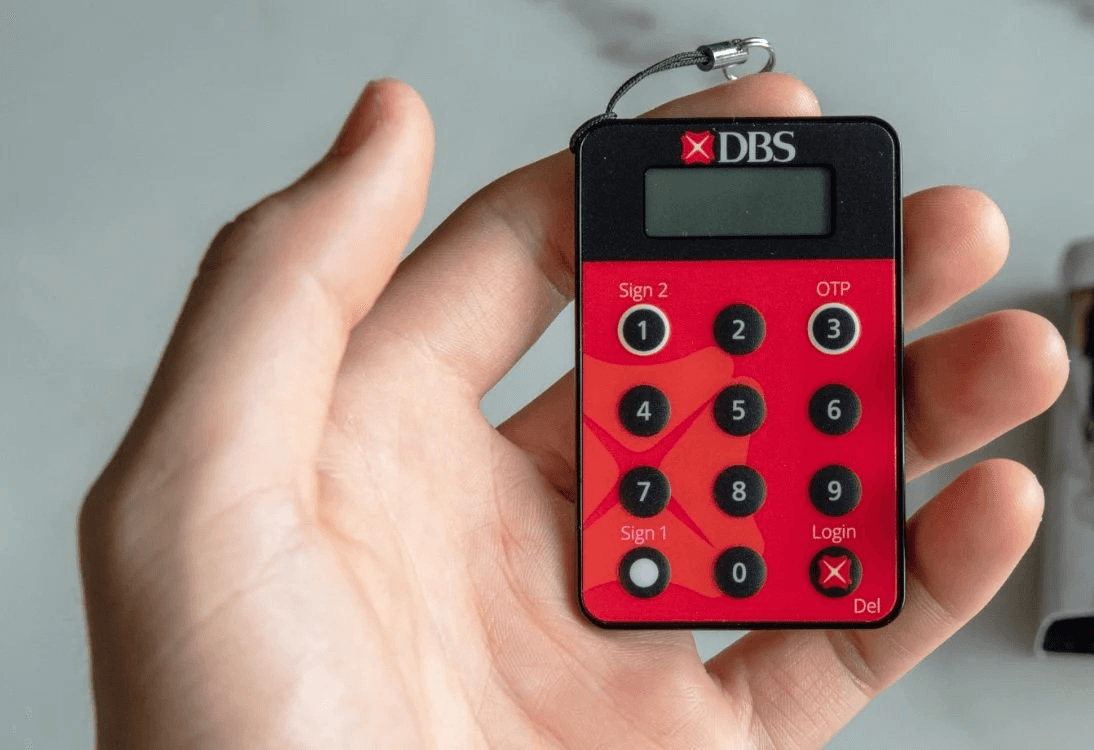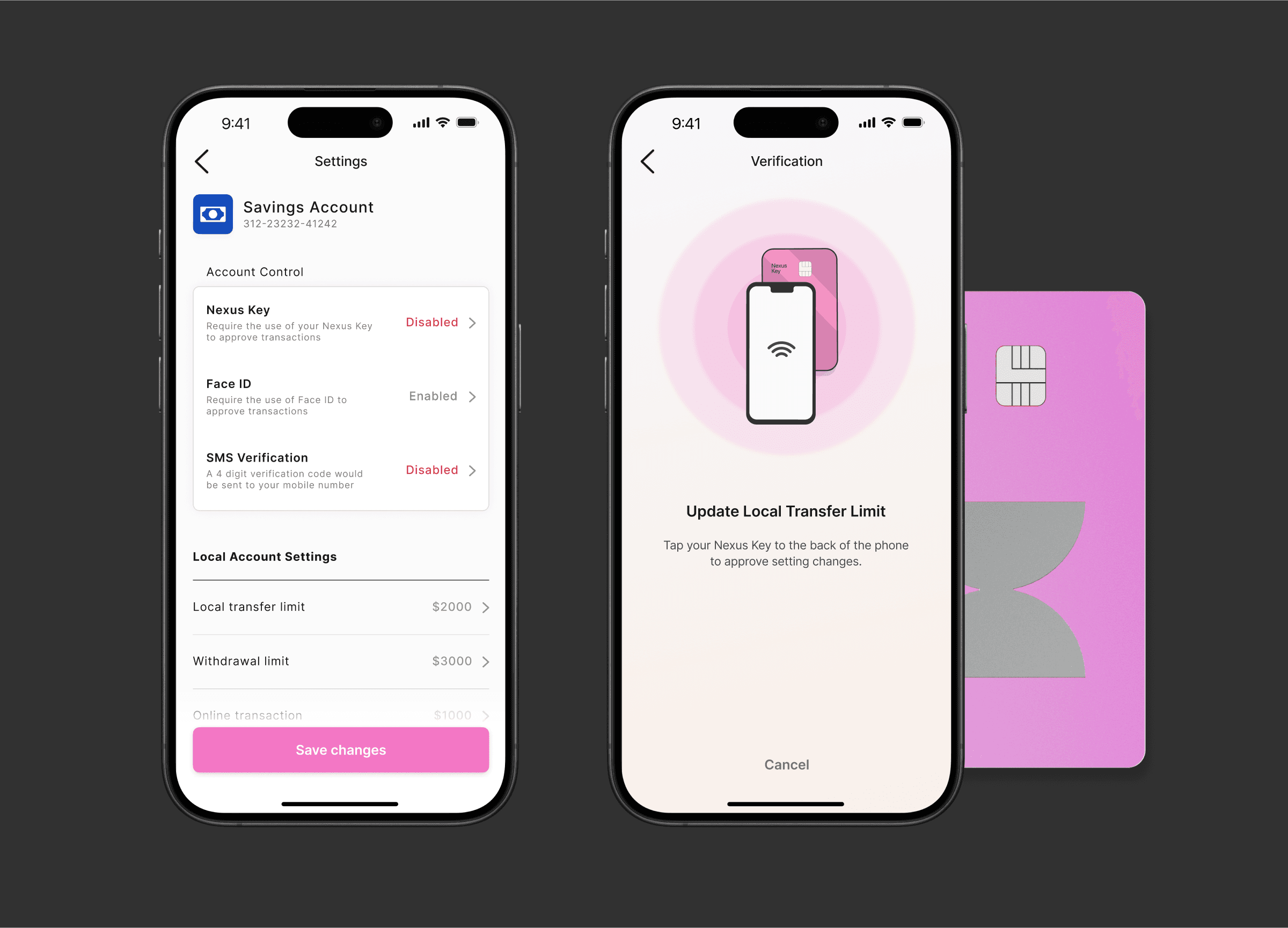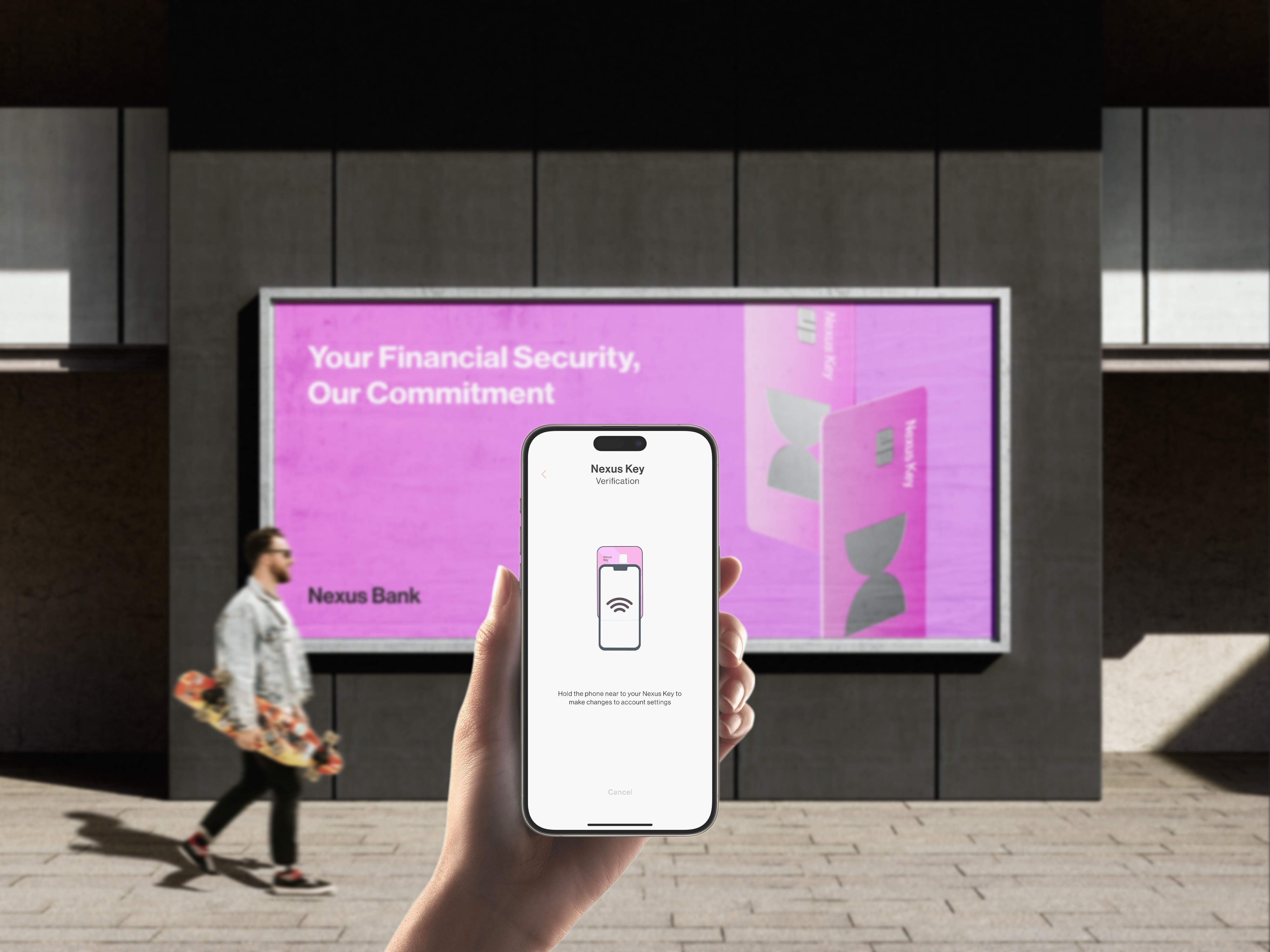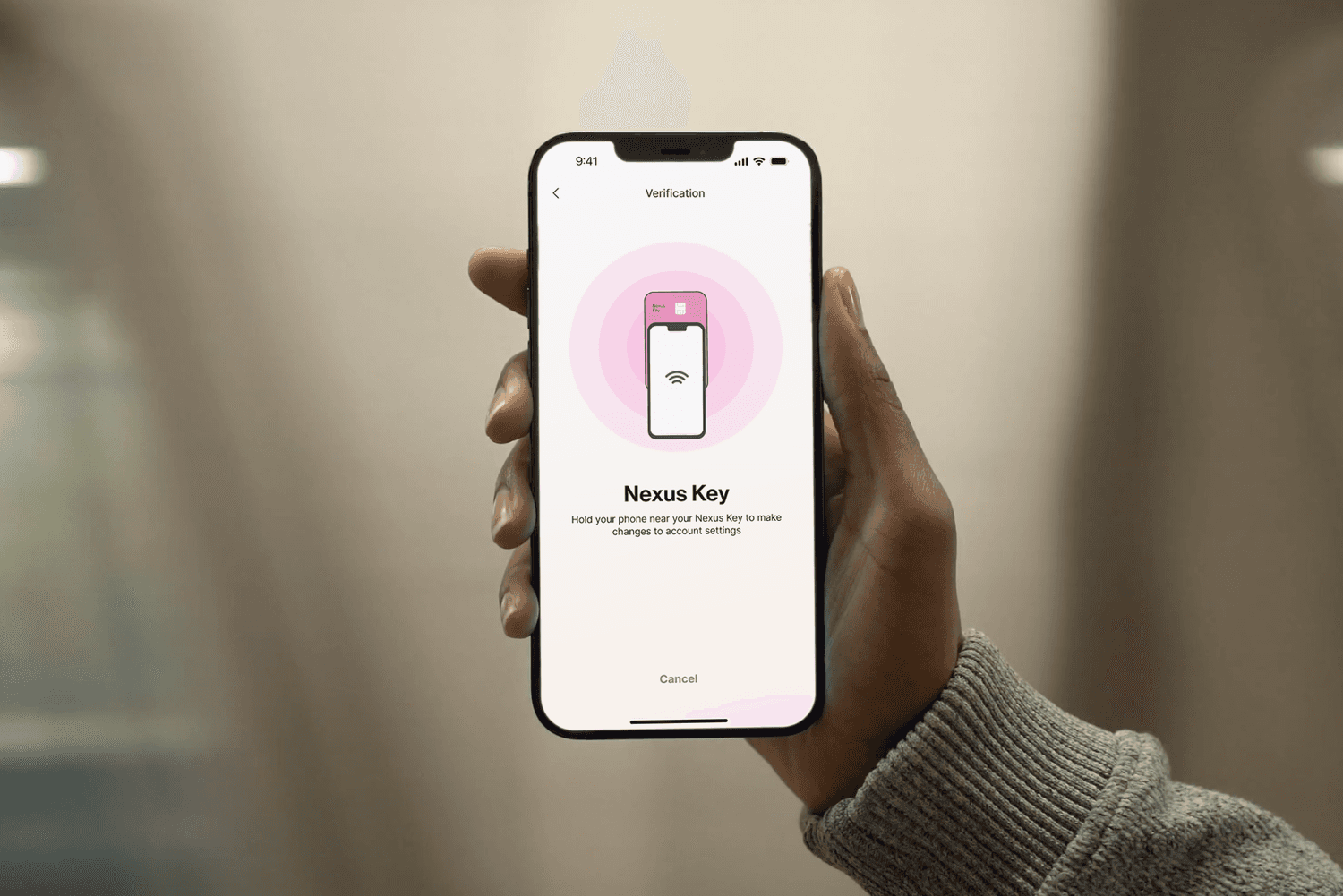Innovation Project
My Role
UI design, Branding
Participated in: User Research
Timeline
Jun 2023 - Aug 2023
Oct 2024 - Oct 2024
Tools
Figma, Miro, Rhino, Keyshot, Photoshop, Illustrator
Problem
Banking users are not doing enough to secure their account
Banking institutions offer a range of security measures designed to protect users. Yet, there has been a rise in financial fraud. This sparked the question - are security measures lacking?
Solution
Closing the Gap Between Bank Security and User Awareness
While users understand digital security, they often don’t follow secure best practices. They see security measures as tedious and overestimate their safety, leading to updates only when necessary. Nexus simplifies financial security, enabling users to easily track and update their settings to protect their accounts.
Clear Account Status
Having the combined account balance on the top and prominently displayed provides clear account status information.
Key detailed such as spending, account values are organised to provide a better breakdown of the account.
Settings at a Glance
The settings are organised to provide a clear and comprehensive overview.
The settings tab shows account information and options, making it easy for users to view and make changes.
Financial Insights
Track transaction history and identify suspicious transactions by simplifying the view.
Information is presented visually to highlight spending insights, categories, and notifications.
Flexible Security Measures
Customise account security based on individual needs and risk levels. By identifying the different risk levels associated with common banking features, users can tailored security measures accordingly.
Effective 2FA
Nexus Key enables confident authorisation of transfers and account changes. Uses NFC for convenient two-factor authentication (2FA), ensuring changes are intentional and require physical possession of the key.
Security with ease

Nexus Key
Seamless security at your fingertips.
Effortlessly protection.
DISCOVER
The Rise in Financial Fraud
Being a avid user of digital technology and finances, I’ve naturally becoming interested in digital security and challenges that affect us.

One major issue is the rise of banking fraud. In Singapore, approximately 88% of banking transactions were conducted via mobile apps in 2022. However, this has also attracted the attention of cybercriminals, who are increasingly targeting these banking applications.
BUSINESS OPPORTUNITIES
By enhancing the security and usability of our banking app, we effectively reduce the risk of scams, boosting consumer trust and perception. This also decreases the need for extensive investigations, ultimately driving the bank's growth and profitability.

This case study highlights the anticipated business benefits and provides a realistic assessment of the potential Return on Investment (ROI) from this project.
20% Reduction in Scam: By improving security measures aimed to lower the risk of scams.
30% Increase in User Trust and Satisfaction: Improving the perception of Nexus Bank as a secure and reliable entity.
30% Decrease in Support Costs: Better app security will reduce the time and resources needed to handle security issues.
15% Improvement in Customer Acquisition: By integrating robust security features and delivering a positive user experience, to become a more appealing choice for new customers.
Secondary Research
Starting with research, I explored articles and studies to understand the scale and impact of the problem. I discovered an interesting trend: unauthorised account access is the most common type of fraud. This insight is important for gaining a deeper context about the issue.

Third-party account takeover is an attack where someone gains unauthorised access to a user’s account on another platform, service, or app. This usually occurs through phishing, credential stuffing, social engineering, or security flaws.
Age group
I found an interesting trend: young people are more likely to fall for scams. This insight helps provide important context for the issue.

Individuals aged 20 to 39 are particularly vulnerable to scams, despite being digitally savvy. They account for 53.5% of all reported scams in 2022.

While the rise in banking fraud isn't solely due to inadequate security measures. It raises a crucial question: Do current security settings effectively protect users when their accounts are compromised?
RESEARCH SUMMARY
Research Methods

Primary Research
12 in-person interviews, shadowing
Research Objectives
Identify user pain points
Analyze user thoughts and experiences
Understand usage context

Competitor Analysis
Analysis of POSB, HSBC, and OCBC apps
Competitor Analysis Objectives
Analyze core features of competing apps
Evaluate usability and security settings
Analyze common pain points

Synthesis
Affinity Mapping, Personas & Prototyping
Gathering Insights
Organise insights into actionable themes
Create personas representing target audience
Design solutions based on insights
Impact: Beyond the Numbers
I wanted to understand how this problem has affected users. So, I compiled insights from various sources about their experiences and the impact on their lives.
Looking at news and reports to understand the scale and impact of the issue.
92% - of consumers are concerned about online banking fraud
56% - believe online banking fraud attempts to be rising
$651.8m - lost to fraud in Singapore in 2023
46,000 - cases reported in 2023
Research Synthesis
From the insights gathered from the primary research, we identified 5 major pain points to address that are crucial to helping users keep their accounts safe.

Key Insights
Insights from the research
Based on the user pain points and research findings, I identified the key criteria to focus on.
This led me to two main problems to address.
KEY TAKEAWAY #1
Users are aware of scams and risks related to digital security. However, this does not translate to understanding their account's safety.
KEY TAKEAWAY #2
The settings and options available are overwhelming and confusing for users, making it difficult to manage effectively.
Design Principle
Actionable Insight
As we address the complexity and disconnect users experience with personal security, we recognised the need for our interface to offer actionable insights. Consistency, ease of navigation, and convenience are essential to create a secure banking experience that aligns with users' mental models. Our goal was to design an interface that prioritises security while remaining flexible to ensure real-world success.
High Fidelity Design

Pushing the boundaries of 2FA
Two-Factor Authentication is essential for strengthening digital security by adding a second layer of verification.
Enhanced Security: Provides an additional layer of protection, minimising the risk of unauthorised access even if passwords are compromised.
Mitigation of Phishing Attacks: Reduces the effectiveness of such attacks, as attackers would still need the 2FA to gain access.

Current 2FA and its issues
SMS verification provides easy two-factor authentication (2FA) using one-time passwords (OTPs) sent to a phone. However, it can be intercepted though malware and other types of attack.
Physical tokens offer stronger 2FA since they are separate from phones, but banks have largely phased them out due to high costs and user inconvenience. They also require more steps, making them less user-friendly than digital methods.
Introducing Nexus Key
Users can secure their accounts easily with Nexus Key, allowing them to authorize transfers and make changes confidently. The system uses NFC for convenient two-factor authentication (2FA), ensuring all changes are intentional and require physical possession of the key.
Approve setting changes using Nexus Key
Secure your account effortlessly with Nexus Key. Use your phone's NFC to scan the key for added security. Authorise transfers and make account changes with confidence.

Step by step introduction
Introduction to the various security features to help users setup and showcase the available security measures available.
Using illustrations and short copy to guide users step by step ensuring that they are not overwhelmed.

01. Efficiently Guiding Users to Critical Financial Data
Easily see the status of one's financial account
Users don’t spend a lot of time in banking apps. Therefore, our design needed to prioritise easy access to key features and allow users to quickly view their account status and spot issues.

Visual emphasis on Account Balance: Provides a high level overview of the account's financial status, allowing the user to see if there has been any major movement of funds.
Quick payment options: During user interviews, all users have highlighted that making payment is one of the main reasons they use the app. We placed the common payment options on the home screen to facilitate user flow and reduce the time spend in to app.
Identify monetory outflow with Spending Insights: A visual indicator that highlights financial history, making it easier for users to identify unusual spending patterns at a glance.
Overview of various accounts: A high-level overview of the financial state of the various accounts. This improves users' understanding of their account status, allowing users to spot and identify issues pertaining to the compromised account.
02. Segmenting Information
Ensuring that spendings are easily tracked
For each account, we designed a clear display of the associated settings, helping users easily link and understand how these settings relate to their account details.

An insight that was uncovered during research was that users felt overwhelmed when using banking apps. They felt that the app had too much information go on and had difficulty locating information.
Overview page: A summary of the financial trends and spending insights by category. This gives the user a clear picture of their finances and makes it easier to track unauthorised spendings.
Search: Having the ability to search past transactions allows users to track any unauthorised spends and makes it easier to gather similar transaction details.
Security information: Users can easily view the security settings associated with their account and easily make changes to further secure their account.

I initially aimed to fit all the information onto a single page to avoid scrolling. However, I soon realised that while it included all the necessary details, it compromised the ease of finding information.
To improve this, I transitioned to a scrollable layout. This approach allowed me to utilise the full width of the screen and create better spacing, enhancing information chunking. Ultimately, this change significantly improved readability and consistency.
We have organised the settings to align with users' mental models, making it easier for them to find what they need.
Providing insights on how secure the account is based on the user’s finances, habits and usage.
In the settings tab, settings are separated by profile and app setting as well as account setting. Notable security settings are highlighted.
03. The Vault
The Vault is a secure savings account where funds can be securely locked away, and withdrawals can only be made in person at the bank. This account shields your funds from online threats, preventing unauthorised digital withdrawals.

To reduce the amount of information users need to look thorough, we broke down key information into cards that are easily glanceable.

An issue that we discovered when testing was that although cards were great for structuring the different setting, it was difficult to fit all the important information.

I recognized that users might struggle to track various account information within the app. To address this, I designed multiple tabs to enhance information density while organizing content into manageable chunks for better user understanding.
What I Learned
Focus, focus, focus
During the design process, I tried to solve more problems to make the app better. I presented my work to several talented designers and received helpful feedback that kept me on track.
Keep it low-fi
When I was designing the app, I was overly confident with what I had and did not set a reviews in the process. I learned to reach out to other designers to get their feedback before moving on to the next stage.
Next Step
Testing
Map out a user testing plan through a click-through prototype on Figma to conduct usability tests to get an in-depth understanding of how users interact with the new interface.
Considering business needs and ROIs
When talking with industry designers, they emphasised the importance of aligning the project with business needs to ensure their support, which is crucial for success. The next step for this project is to test and validate the designs and how effective it tackles the problem.











